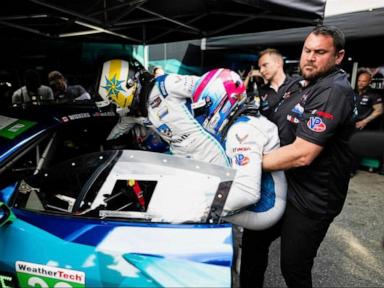LONG BEACH, Calif. (AP) — Nearly seven years after he was paralyzed in an IndyCar crash, Robert Wickens will return to elite competition on Saturday when he drives a Corvette in the IMSA sports car race on the downtown streets of Long Beach.
Wickens has raced since the crash at Pocono left him paralyzed from the chest down but considers the IMSA event a true completion of his comeback.
“My goal from the outset of this was to get back to the highest levels of motorsport again. I’ve always seen that (IMSA) is the highest level of sports car racing here in North America,” Wickens said. “It would be a dream if I could call it a 10-year career here racing against the best drivers in the world and one of the best series in the world.”
Wickens will drive for DXDT Racing with teammate and longtime Corvette driver Tommy Milner. The Corvette is equipped with a hand-controlled throttle and braking system developed by Bosch and Pratt Miller. The brake controls mount to the steering wheel but are independent of the steering wheel so that Milner can seamlessly transition from hand controls to pedals when he’s the driver.
“The steering wheel that Tommy will be driving or any other teammate that I drive with in this Corvette, it’s the exact same steering wheel that they always know. What’s great about it is, in theory, it can mount to virtually any steering column as long as you have the right bolt pattern,” Wickens said. “What we’re learning here today can transfer into any race car. And then, hopefully, down the road, what we’re developing with the electronic braking system from Bosch, opportunities are endless. Maybe this can evolve into road safety and into everyday road vehicles and accessibility in road vehicles.
“But short term, we need to perfect this system here.”
Wickens has most recently been a driver for Bryan Herta Autosport in the Michelin Pilot Challenge, which is a lower division of IMSA and in 2023 he won a class title. He’s tested a Formula E car, did a demonstration for Honda in Canada, where he’s from, and now will make his debut in IMSA’s GT Daytona class.
“Honestly, taking the green flag in Long Beach is going to be an enormous step forward in my career and my journey back to the highest levels,” Wickens said. “You could say, ‘We did it. We’re racing against the best cars and the best drivers in the whole sports car industry.’”
The car Wickens and Milner are competing in is eligible for the GTD championship.
“I want to win championships for myself, for General Motors, for DXDT,” he said. “There’s still some work to be done. I think you could say it’s definitely a massive box to check, probably the biggest box that we could check off so far in my return.”
He’d like to race full-time in the series next season.
He and Milner are just getting to know each other, as well as the nuances of the car with the system Wickens must use versus how Milner will drive it.
“In Robbie’s case he has to do all of his driving with his hands. This system is basically set up so that he can do all that with the steering wheel itself,” Milner said. “There’s a brake ring and there are throttle paddles that take the place of what I would normally use in the pedal box. The system is quite impressive with how it functions and how it works. With just one push of a button, the system switches from the able-bodied driver controls to the hand controls, which obviously is important for sports car racing where we have driver changes.
“Fundamentally, everything happens on the wheel. And it’s a system that took me initially a little while to sort of understand in my own brain, how it is supposed to work, how to find lap time out of it and things like that.”
Milner has also been inspired by Wickens’ journey since his life-changing crash in his rookie season of IndyCar ...




